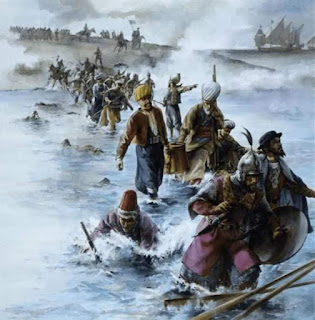THE GREAT SPANISH RESCUE OF MALTA (1565)
THE GREAT SPANISH RESCUE OF MALTA (1565)
The Grand Master of the Order of Malta, Jean Parisot de la Valette, ordered the small garrison at Saint Elmo to resist to the death. He still could not imagine that the survival of an order of crusaders with centuries of existence was going to be at stake there. Built in solid stone, this fortress located in front of the capital was defended by only 100 knights and 500 soldiers, the majority Spanish and Italian, who received fire from artillery pieces of dimensions never seen before.
The impression that the defenders were supernatural beings permeated the Turkish ranks, who spent a month shelling a ruin that occasionally coughed up gunpowder, as a reminder that there was life within. A titanic effort that, among the many that the Maltese undertook in the face of the Ottoman attack of 1565, allowed the Spanish Empire to break the blockade months later and stage what is known as "The Great Rescue of Malta".
In Malta the balance of forces in the Mediterranean began to change, or at least that is how Christian Europe saw it, which responded furiously to the cry for help. García de Toledo (Viceroy of Sicily) planned with the poor resources available to a relief squad in a reasonable time. The effort was to unite a fleet of galleys, capable of breaking the blockade, and a land group that could face the deployed Muslim troops.
The rescue took time to wait, but on September 7 the key step was taken. the Spanish Grand Admiral Don Álvaro de Bazán, who would be key in Lepanto, defeated the Turkish defense line with 60 galleys. Bazán devised a brilliant plan, whereby the 60 fastest galleys would each embark 150 soldiers and move the men ashore before the Turks could react.
Embarked on the rescue fleet were troops of the field master Gonzalo de Bracamonte, coming from Córcega, Sancho de Londoño, coming from Lombardy, and those of Álvaro de Sande, coming from Naples. The bulk of the Christian forces was made up of the Tercio de Sicily, contributed by García de Toledo (he was seriously ill with gout at that time). The Duke of Florence and the Duke of Genoa also sent several vessels.
After several frustrated attempts due to bad weather, on September 7 the indicated galleys disembarked in the Melecha cove, in the northwest of the island, with 9,600 men. On land, the Spanish forces quickly formed the feared cadres of the tercios and embarked on a three-day march. The Turks – considering that it was only the outpost of an even larger army – called a retreat.
However, at the last moment a Moorish soldier went over to the Turks and informed them that they were still outnumbered. Mustafa suspended the embarkation and prepared for combat. Seeing the enemy nearby, Álvaro de Sande –at the forefront of the Spanish vanguard– charged the Turks who were about to take possession of a hill, with a single company of arquebusiers and without waiting to put on their armor or receive orders. The demoralized Turks were quickly convinced that there was no other option but to flee. On the 12th, the last Turkish galleys left the island.
With the inability to conquer Malta, the Turkish Empire put its weaknesses on the table and Suleiman "The Magnificent" missed the opportunity to put the finishing touch to a brilliant reign. The Christian kingdoms regained military confidence and were quick to regain the initiative, as they demonstrated at the Battle of Lepanto seven years later.
The architect of the persistent defense, Jean Parisot de la Valette, was rewarded by Felipe II with a sword and a dagger of Toledo steel with gold trimmings and precious stones engraved with the Latin legend "PLVS QVAM VALOR VALETTA VALET" ("Valletta is worth more than the same value"). Since then, the sword and dagger of Valor have paraded every September 8 through the streets of Valletta following the Maltese Cross banner bearer.
Source: https://www.abc.es/historia-militar/20150507/abci-rescate-espanol-malta-ataque-201505061747.html













Comments
Post a Comment